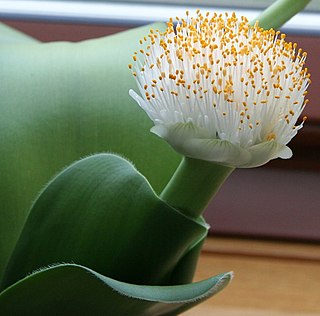
Haemanthus is a Southern African genus of flowering plants in the family Amaryllidaceae, subfamily Amaryllidoideae. Members of the genus are known as blood lily and paintbrush lily. There are some 22 known species, native to South Africa, Botswana, Namibia, Lesotho and Eswatini. About 15 species occur in the winter rainfall region of Namaqualand and the Western Cape, the remainder being found in the summer rainfall region, with one species Haemanthus albiflos occurring in both regions.

Haemanthus amarylloides Jacq. is an endemic South African bulbous plant. It was first described in 1804 by Nikolaus Joseph von Jacquin from specimens sent to the Schönbrunn Palace gardens by the collectors Boos and Scholl. Franz Boos was an Austrian botanist who, with Franz Bredemeyer, made up Emperor Joseph II's gardening team. Boos and his assistant Georg Scholl, were collecting Cape plants for the imperial gardens. These collections were transported to Vienna by Nicolas Thomas Baudin, who had been carefully briefed by Boos on the techniques used for keeping plants and animals alive on long ship voyages.

Haemanthus coccineus, the blood flower, blood lily or paintbrush lily, is a species of flowering plant in the amaryllis family Amaryllidaceae, native to Southern Africa. Growing to 35 cm (14 in) tall and wide, it is a bulbous perennial with short brown stems surmounted by red flowers, the flowers appearing in spring and summer, before the strap-shaped leaves.

Haemanthus canaliculatus is a South African bulbous geophyte in the genus Haemanthus of the amaryllis family (Amaryllidaceae). The common name is fireball lily. It is found only over a small area in the Western Cape between Kleinmond and Rooiels, growing at about 30 m above sea level with an annual rainfall of 650 mm. Its favoured habitat is under dense bush in seasonally inundated shallow depressions, where it usually occurs in clumps. The leaf-bases or tunics of the bulb are thick, fleshy, distichous and loosely separated as in the spread fingers on a hand cf. Haemanthus pubescens. Leaves are from one to four, red-barred at the base, held in a sub-erect position and appear after the flowers. The peduncle is up to 200 mm long with 5-7 spathe valves that are bright red to pink in colour. Fruits are about 20 mm in diameter and reddish. Seeds are shiny and deep red.
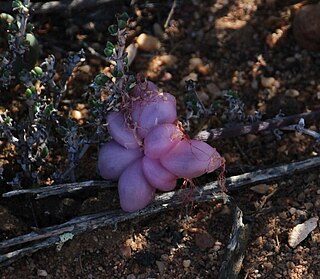
Haemanthus crispus is a South African bulbous geophyte in the genus Haemanthus and occurring in Namaqualand which lies in the winter rainfall region. It is a common species and is found from Steinkopf to the Olifants River, growing from the coastal flats eastwards onto the stony, lower slopes of the first terrace, usually in heavy soils and often in the shade of low succulent shrubs.

Haemanthus dasyphyllus is an endemic South African bulbous geophyte, one of about 20 species in the genus Haemanthus, and is found near Loeriesfontein in Namaqualand.

Haemanthus pubescens is an endemic South African bulbous geophyte in the genus Haemanthus.

Scadoxus puniceus, commonly known as the paintbrush lily, is a species of bulbous plant. It is native to much of southern and eastern Africa: Ethiopia, Sudan, Tanzania, Malawi, Mozambique, Zambia, Zimbabwe, Botswana, Eswatini (Swaziland), and South Africa. Scadoxus puniceus can be found in cool, shady habitat such as ravines and forests, where it is often found in moist leaf litter. Other common names include snake lily, royal paintbrush, King-of-Candida, African blood lily (English), rooikwas (Afrikaans), isisphompho, and umgola (Zulu). There are nine species of Scadoxus of which three, S. puniceus, S. multiflorus and S.membranaceus, occur in South Africa.

Scadoxus is a genus of African and Arabian plants in the Amaryllis family, subfamily Amaryllidoideae. The English names blood lily or blood flower are used for some of the species. The genus has close affinities with Haemanthus. Species of Scadoxus are grown as ornamental plants for their brilliantly coloured flowers, either in containers or in the ground in frost-free climates. Although some species have been used in traditional medicine, they contain poisonous alkaloids.

Scadoxus cyrtanthiflorus is a herbaceous plant endemic to the Rwenzori Mountains of east tropical Africa. Unusually for the genus Scadoxus its tubular blooms are pendant. It is sometimes grown as an ornamental plant in heated greenhouses.
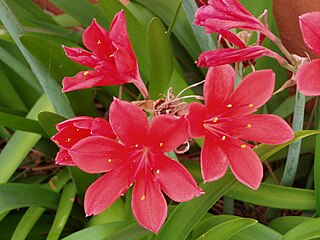
Cyrtanthus is a genus of perennial, herbaceous and bulbous plants in the family Amaryllidaceae, subfamily Amaryllidoideae.

Boophone disticha is a bulbous tropical and subtropical flowering plant, endemic to Africa. Commonly called the century plant or tumbleweed, Boophone disticha was first collected in 1781 from South Africa by Swedish botanist Carl Peter Thunberg and described by Carl Linnaeus as Amaryllis disticha. Since that time it has been placed in the genera Brunsvigia and Haemanthus, finally coming to rest as Boophone. The genus name itself was spelled in three different ways by the author William Herbert, straining the procedures of the rules of nomenclature. The etymology of the genus is from the Greek bous = ox, and phontes= killer of, a clear warning that eating the plant can be fatal to livestock.

Scadoxus multiflorus is a species of bulbous plant native to most of sub-Saharan Africa from Senegal to Somalia to South Africa. It is also native to Arabian Peninsula and to the Seychelles. It is naturalized in Mexico and in the Chagos Archipelago.It is also found in Indian peninsula. It is grown as an ornamental plant for its brilliantly coloured flowers, either in containers or in the ground in where the climate is suitable. There are three recognized subspecies. Strongly toxic like other Scadoxus species, it has been used as a component of arrow poisons and fishing poisons, as well as in traditional medicine. Common names, some of which are used for other species, include blood lily, ball lily, fireball lily, blood flower, Katherine-wheel, oxtongue lily, poison root and powderpuff lily.
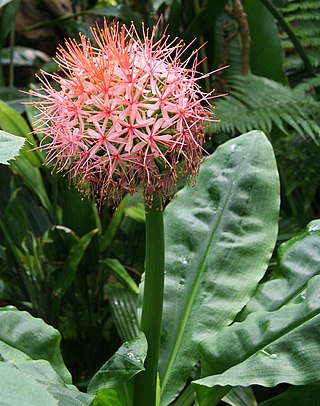
Scadoxus cinnabarinus is a herbaceous plant from tropical rainforest in Africa. It is native to Western and Central Africa from Sierra Leone in the far west to Angola in the south. It has been reported from Ghana, Côte d'Ivoire, Nigeria, Niger, Sierra Leone, Central African Republic, Cameroon, Congo, Equatorial Guinea, Gabon, São Tomé, Zaire, Uganda, and Angola.
Scadoxus longifolius is a herbaceous plant from Zaire. It is only known from a single collection, and little information is available about it. It appears to be closely related to Scadoxus cinnabarinus, and Inger Nordal and Thomas Duncan suggested in 1984 that it may not be a distinct species.

Scadoxus membranaceus is a flowering plant in the Amaryllidaceae family. It is a bulbous plant from South Africa. The smallest of the species of Scadoxus, it is sometimes cultivated as an ornamental plant where a minimum temperature of 5 °C (41 °F) can be maintained.

Scadoxus pole-evansii, commonly known as the Inyanga fireball, is a herbaceous plant endemic to mountains in east Zimbabwe. It was only discovered for science in 1960. Similar in many respects to the more widely grown Scadoxus multiflorus, it is cultivated as an ornamental plant.
Scadoxus pseudocaulus is a herbaceous plant native to Nigeria, Equatorial Guinea, Cameroon and Gabon. Similar in many respects to Scadoxus cinnabarinus, it is cultivated as an ornamental plant but has proved reluctant to flower.
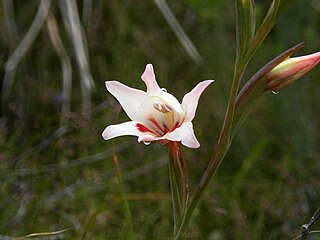
Gladiolus carneus is a plant species in the family Iridaceae.

Dierdré "Dee" Anne Snijman is a South African botanist and plant taxonomist who is notable for studying and writing extensively on bulbs. She has described over 120 species and has written comprehensive works on South African flora. She received the 1997 Herbert Medal from the International Bulb Society for her research on Amaryllis.



















